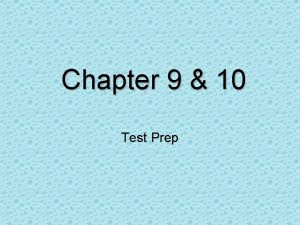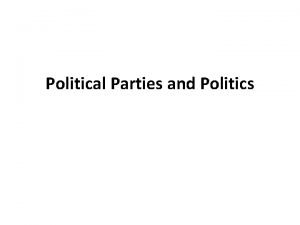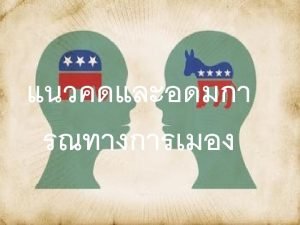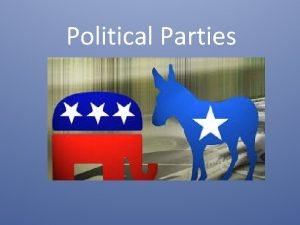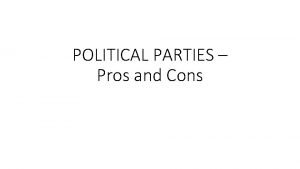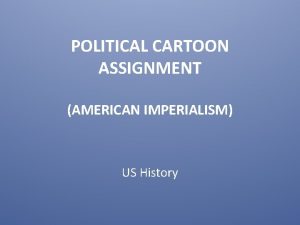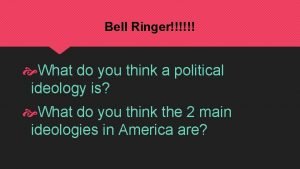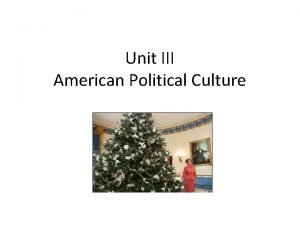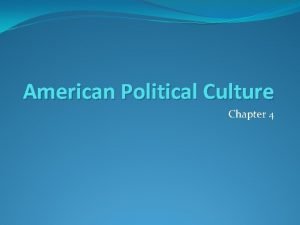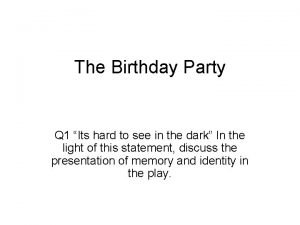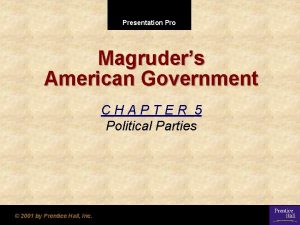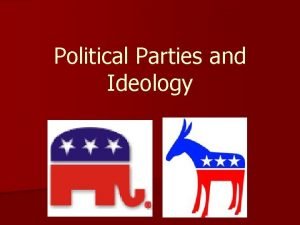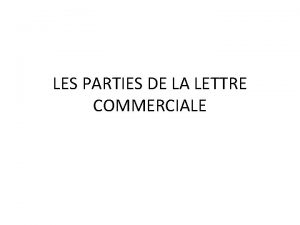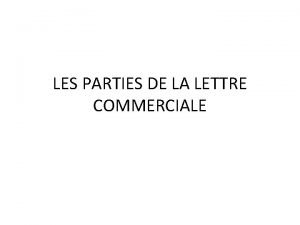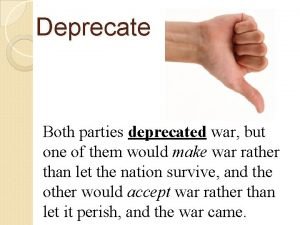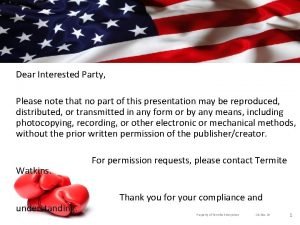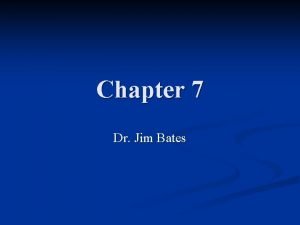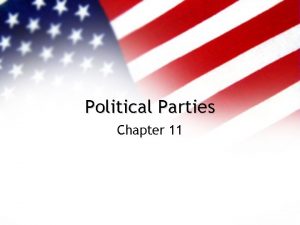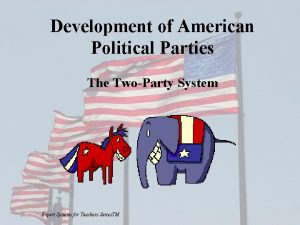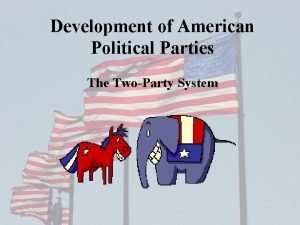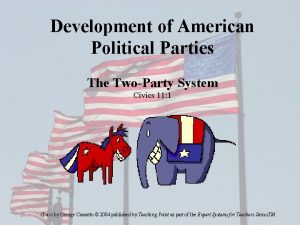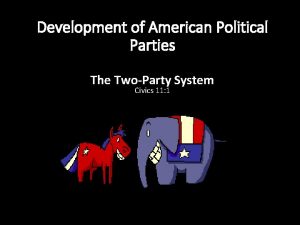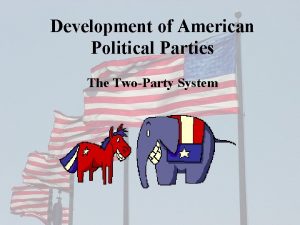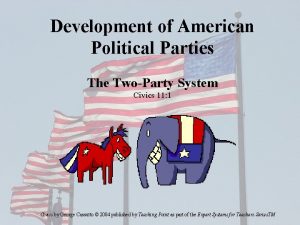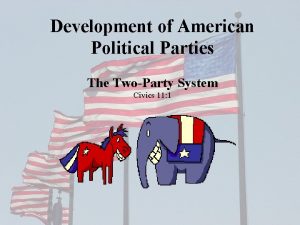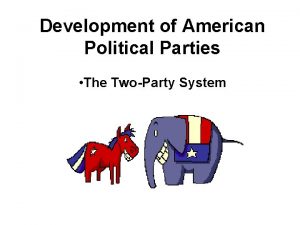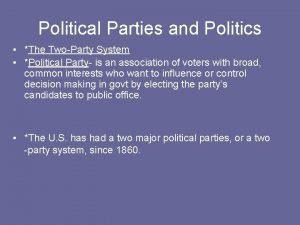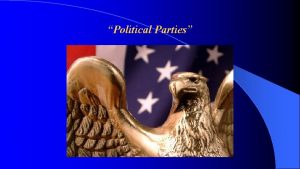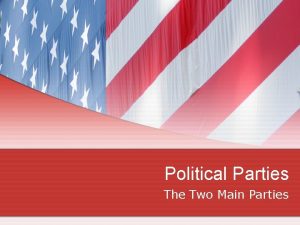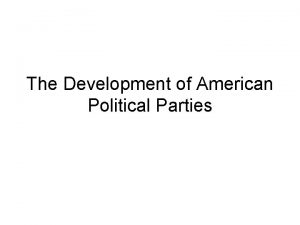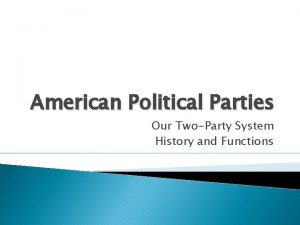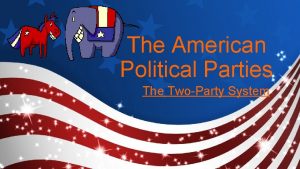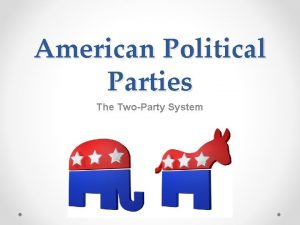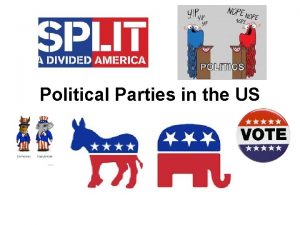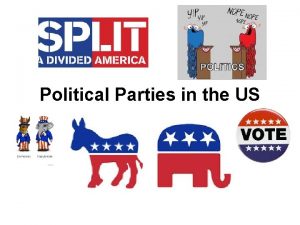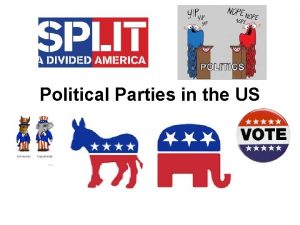Development of American Political Parties The TwoParty System



























- Slides: 27

Development of American Political Parties The Two-Party System Expert Systems for Teachers Series. TM

What Is a Political Party? • A political party is a group of citizens with broad common interests who agree on major issues facing the nation. These groups work to influence government and create public policies that reflect their views.

Functions of Political Parties • Choose, or nominate, people they want to elect to public office. These candidates campaign to get elected. • Educate the public and inspire voters. • Help govern: Operate on partisan lines in Congress and State legislatures. • Serve watchdog role as “loyal opposition. ” • Dispense patronage.

Parties in the US • Any American citizen may join a political party, but most members are 18 or older. • The U. S. has a two-party system. • The Republicans emerged as a major party in 1860 with the election of Abraham Lincoln. • The Democratic Party formed under Andrew Jackson three decades earlier.

Hamilton vs. Jefferson First Political Parties • Political parties first emerged when followers of Alexander Hamilton and Thomas Jefferson disagreed over major issues on the Constitution and government. • Jefferson’s supporters were called Democratic. Republicans. They feared a strong central government, wanting states to hold greater power. • Hamilton championed a strong national government with a powerful chief executive. His followers were called Federalists, after those who supported the Constitution.

Jacksonian Democracy • In 1828, members of Jefferson’s party, calling themselves the Democratic Party, nominated Andrew Jackson. He stood for the common citizen (farmers, small business owners), and looked out for southern and western interests. • Those who opposed Jackson formed their own party called Whigs, although their real name was the National Republican Party. • The Whigs and Democrats made up the two key parties in American politics for two decades.

The Two Major Parties Emerge • In 1854, some Whigs, former Free Soil Party members, and ex-Democrats formed the Republican Party to oppose the spread of slavery in US territories. https: //www. youtube. com/watch? v=o. Www 0 YIf-JE&index=1&list=PLIhqfb. AUYf. DFCui. QD 9 ZRAFti. HTA 11 d. Pli • The Whigs faded from American politics leaving the Democrats and Republicans in a two-party system that has dominated American politics ever since.

Third Parties • Any party other than the two major parties can be called a “Third Party, ” or “Minor Party. ” • No third party has ever gained control of the White House. Sometimes, third parties win seats in Congress or gain office in lower levels of government. • When these smaller groups challenge the two major parties, they can change the outcome of elections. • Their most important role is to influence policy on one or more issues. Ralph Nader, Green Party Candidate, 2000

Types of Third Parties • • Ideological Parties Economic Protest Parties Splinter Parties Single-Issue Parties

Economic Protest Third Parties • In the late 1800 s, the People’s Party, or “Populists” became popular. • They had the support of farmers and workers who called for better working conditions. • They never succeeded in getting a national candidate into office, but many of their ideas on workers’ rights became laws in the 20 th Century.

Splinter Parties • Former Republican President Theodore Roosevelt left the Republican Party and was nominated by the Progressive Party. • It was nicknamed the “Bull Moose Party” because TR said he was “fit as a Bull Moose”. • TR split the 1912 Republican vote, allowing Democrat Woodrow Wilson to defeat President William H. Taft.

Ideological Third Parties • An ideology is a body of ideas put forth by a person or group. • Ideological parties want to change society in major ways. (The Socialist and Communist Parties want to nationalize major industries. ) Single-Issue Parties • Minor parties are often formed to support a specific issue. These rise and fall over time. (The Green Party calls for companies to respect the environment. )

Cult of Personality • Some third parties form from the efforts of famous people. • If they cannot gain support from one of the major parties, they form their own. • H. Ross Perot’s Reform Party was a force in the 1992 and 1996 elections. This party also placed pro wrestler Jesse Ventura in the governor’s mansion in Minnesota. • These parties usually fade after their candidate is defeated.

The Odds Are Against Them • It is difficult for third parties candidates to raise enough money to compete with the major parties. • Single-member Districts: Only one candidate can win in a given district. Usually the winner is either Democratic or Republican. • Third-party candidates must show they have support by getting enough voter signatures to even be placed on the ballot. • Their best ideas are often adopted by the major parties

Party Systems in other Countries • Most democracies have multi-party systems. • One party rarely wins the number of seats in the Parliament needed to control the government. This instability forces several parties to cooperate in running the government. When parties work together to pass laws, a coalition has been formed. • Multi-party systems may be unstable. If a party pulls its support, the government can collapse and new elections must be held. This process occurs in nations with a parliamentary system.

Following The Party Line • A one-party system cannot exist in a democracy. There is no choice of candidates in the elections. • Opposition parties are usually banned. • Communist China, Cuba, and North Korea operate under oneparty systems. One-party systems may be based on other ideologies such as religion. • Iran's Islamic Republican Party has established a Muslim state. This type of religion-based government is called a theocracy.

Parties in Non-democracies Functions: • Mobilize support for the regime • Recruit and train potential leaders • Oversee the bureaucracy • Serve as means of social control (spy on population, etc. )

History of Modern Parties in America • After Lincoln’s election, Republicans remained the majority party from Civil War until 1932. • Democrats gained majority during Great Depression. They controlled Congress for next 6 decades, and largely held the White House until 1968. • Then, except for 3 terms, Republicans controlled the White House until 2008.

American Politics Today • Democrats usually feel that the federal government has a responsibility to help those in need through government intervention, and that government regulation is the best means of protecting public interests. • Republicans hold the view that leaving the economy alone will allow for greater growth, giving people better ability to help themselves. They believe in less regulation.

What is an ideology? A set of ideas (values, expectations, myths) about how society should operate. Democrats are generally associated with Liberal ideology; Republicans with Conservative ideology.

Liberals Those who believe government should do more to solve the nation’s problems, but reject the notion that government should favor a particular set of social issues. Liberals are associated with change and “big government. ”

Values of Liberals • Equal opportunity (Access to education, job training, professional promotion, etc. ) • Equality for all (Due Process of law) • Duty of state is to protect civil liberties, alleviate social ills, and promote human rights • Idea of state as “nurturing mother”

Conservatives Those who believe government tries to do too many things that should be left to firms or individuals, but look to government to uphold traditional values. Conservatives are associated with status quo and “small government. ”

Basic Values of Conservatives • • • Personal responsibility Limited government Traditional values Free markets (laissez-faire) Strong national defense Duty of gov’t to provide freedom necessary for people to pursue their own goals • Idea of government as a “strict father”

Parties Move Towards The Center • Platform: statement that puts forth the party's positions on issues. Each individual issue is called a plank. • To obtain more votes, both parties become more moderate in their platforms, moving away from extreme positions in general elections. • Americans broadly agree about many issues. This unity forces the two parties toward the center of the political spectrum.

Other Ideologies: Libertarians Those who believe government should be strictly limited to essential services. They oppose government as an instrument of managing the economy and upholding traditional values.

Other Ideologies: Populists (Communitarians) Those who believe government should do more to solve the nation’s problems, and look to it to uphold traditional values.
 The spoils system made political parties more powerful by
The spoils system made political parties more powerful by Brainpop voting
Brainpop voting Political parties
Political parties Political parties
Political parties Political
Political Wikimedia
Wikimedia Political parties
Political parties Political parties pros and cons
Political parties pros and cons If a ruby is heated it temporarily lose its color
If a ruby is heated it temporarily lose its color American imperialism political cartoons explained
American imperialism political cartoons explained What does the picture depict
What does the picture depict American political spectrum
American political spectrum American political culture definition
American political culture definition American political culture definition
American political culture definition Metric system vs american system
Metric system vs american system Chapter 5 section 4: the minor parties answer key
Chapter 5 section 4: the minor parties answer key And it's hard to be at a party
And it's hard to be at a party Chapter 5 section 1 parties and what they do
Chapter 5 section 1 parties and what they do Define ideological parties
Define ideological parties Makanan pesta adalah
Makanan pesta adalah Les parties de la lettre commerciale
Les parties de la lettre commerciale Les différentes parties de la lettre commerciale
Les différentes parties de la lettre commerciale Les parties du corps du dauphin
Les parties du corps du dauphin Quality policy
Quality policy Both parties deprecated war meaning
Both parties deprecated war meaning Dear interested
Dear interested Les différentes parties d'un microscope optique
Les différentes parties d'un microscope optique 3. why is myrtle wilson upset when she sees tom and jordan?
3. why is myrtle wilson upset when she sees tom and jordan?
